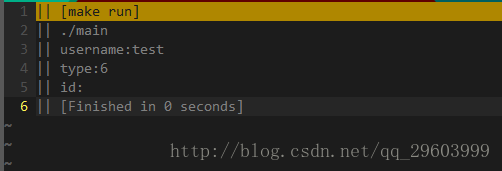- 1autojs一个经典的飘浮工具栏界面源码_autojs悬浮窗ui界面
- 2Unity3D性能优化——渲染篇_unity渲染
- 3Pygame Zero(pgzrun)游戏库介绍
- 4目标检测中的b-box回归损失函数(IOU,GIOU,DIOU,CIOU)_ciou全称
- 5【LVI-SAM代码学习记录】
- 6现代数字信号处理第九章——盲信号处理_盲源分离波束合成算法
- 746、全排列 | 算法(leetcode,附思维导图 + 全部解法)300题
- 8Java正则表达式校验日期格式_java时间yyyy-mm-dd hh:ss正则表达式
- 9pointnet推理部署--libtorch框架_pointnet_pointnet2_pytorch
- 10实现3D物体拆解组装的详细步骤和示例代码_unity用鼠标控制物体拆解
Json使用教程_自己做电视json直播源
赞
踩
Json使用教程
使用第三方静态库的步骤:
1、编译文件生成静态库。
2、把相关的.h文件放入D:\VS2005安装目录\VC\include路径下。
3、把相应的.lib文件放在D:\VS2005安装目录\VC\lib路径下。
在使用中只需要将json.rar中的文件添加(并包含)到项目中
链接:json.rar下载地址
在需要使用Json的文件中添加json.h的头文件即可使用了
使用教程如下:
JsonCpp 是一个C++用来处理JSON 数据的开发包。下面讲一下怎么使用JsonCpp来序列化和反序列化Json对象,以实际代码为例子。
反序列化Json对象
比如一个Json对象的字符串序列如下,其中”array”:[…]表示Json对象中的数组:
{“key1″:”value1″,”array”:[{“key2”:“value2”},{“key2”:“value3”},{“key2”:“value4”}]},那怎么分别取到key1和key2的值呢,代码如下所示:
std::string strValue = “{\”key1\”:\”value1\”,\”array\”:[{\"key2\":\"value2\"},{\"key2\":\"value3\"},{\"key2\":\"value4\"}]}”; Json::Reader reader; Json::Value value; if (reader.parse(strValue, value)) { std::string out = value["key1"].asString(); std::cout << out << std::endl; const Json::Value arrayObj = value["array"]; for (int i=0; i<arrayObj.size(); i++) { out = arrayObj[i]["key2"].asString(); std::cout << out; if (i != arrayObj.size() – 1 ) std::cout << std::endl; } }
- 1
- 2
- 3
- 4
- 5
- 6
- 7
- 8
- 9
- 10
- 11
- 12
- 13
- 14
- 15
- 16
- 17
- 18
序列化Json对象
先构建一个Json对象,此Json对象中含有数组,然后把Json对象序列化成字符串,代码如下:
Json::Value root;
Json::Value arrayObj;
Json::Value item;
for (int i=0; i<10; i++)
{
item["key"] = i;
arrayObj.append(item);
}
root["key1"] = “value1″;
root["key2"] = “value2″;
root["array"] = arrayObj;
root.toStyledString();
std::string out = root.toStyledString();
std::cout << out << std::endl;
- 1
- 2
- 3
- 4
- 5
- 6
- 7
- 8
- 9
- 10
- 11
- 12
- 13
- 14
- 15
删除Json对象
std::string strContent = “{“key”:“1”,“name”:“test”}”;
Json::Reader reader;
Json::Value value;
if (reader.parse(strContent, value))
{
Json::Value root=value;
root.removeMember("key");
printf("%s \n",root.toStyledString().c_str());
- 1
- 2
- 3
- 4
- 5
- 6
- 7
- 8
- 9
- 10
- 11
JSON的嵌套
、json简介
1.JSON来历:JSON(JavaScript Object Notation, JS 对象标记) 是一种轻量级的数据交换格式。它基于 ECMAScript (w3c制定的js规范)的一个子集,采用完全独立于编程语言的文本格式来存储和表示数据。简洁和清晰的层次结构使得 JSON 成为理想的数据交换语言。
2.JSON作用:JSON对象作为一种通用的中间层,用于跨平台跨语言传输数据
3.JSON语法规范:JSON种有四种基础类型(string,boolean,int,null),有两种复杂类型(array,Object),由于不同平台不同语言的差异性,在各自语言有各自对JSON的理解,Object类型可以理解为对象,也可以认为是哈希表,键值对等。复杂类型之间可以互相嵌套,比如array中含有多个Object,而其中的Object又含有array.
4.Linux下C++中使用JSON:有多种方案,这里使用jsoncpp开源跨平台框架, jsoncpp的安装参考如下链接:linux下正确安装jsoncpp框架,或者自己搜索相关博客安装
5.使用JSONCPP框架: 参考上述链接将其安装后,其动态链接库libjson.so已在系统默认库中(/lib/),相关头文件也在默认系统头文件库中( /usr/include/),此时只需在代码中保护相应头文件,如#include < json/json.h>,在链接时加上-ljson参数链接上libjson.so库即可,例如
g++ -c main.cpp -o main.o #编译
g++ -o main main.o -ljson #链接
./main #运行
二 、直接赋值产生json对象
jsoncpp中使用JSON::Value类型来包含Json对象,如下产生简单的Json对象
#include
#include
#include <json/json.h>
using namespace std;
int main()
{
Json::Value a,b,c,d,e;
a = 12; //int
b = “hello”;//string
c = false; //boolean
d = true; //boolean
//eΪnull
cout << “First” << endl;
cout << a.asInt() << endl;
cout << b.asString() << endl;
cout << c.asString() << endl;
cout << d.asString() << endl;
cout << e.asString() << endl;
//也可以使用复制构造函数来初始化生成JSON对象
a = Json::Value(13);
b = Json::Value("hello world");
c = Json::Value(false);
d = Json::Value(true);
e = Json::Value();
cout << "Second" << endl;
cout << a.asInt() << endl;
cout << b.asString() << endl;
cout << c.asString() << endl;
cout << d.asString() << endl;
cout << e.asString() << endl;
return 0;
- 1
- 2
- 3
- 4
- 5
- 6
- 7
- 8
- 9
- 10
- 11
- 12
- 13
}
运行结果如下所示:

三 、从JSON字符流中读取json对象
使用过JSON都知道,JSON对象传输时的形态为字符流,从JSON字符流中取出JSON对象具有重要应用意义
jsoncpp中使用Json::Reader类型来读取字符流中的数据,如下
#include
#include
#include <json/json.h>
using namespace std;
int main()
{
string message = “{ “data” : { “username” : “test” }, “type” : 6 }”;
Json::Reader reader;
Json::Value value;
//如果message符合Json对象语法,则取出该对象存在value中
if(reader.parse(message.c_str(), value))
{
Json::Value temp = value[“data”]; //取出value对象中的data对象,对象嵌套的一种方式
cout << “username:” << temp[“username”].asString() << endl;
cout << “type:” << value[“type”].asInt() << endl;
cout << “id:” << value[“id”].asString() << endl; //取出null
}
return 0;
}
结果如下所示:

四 、将json对象转为字符流
将json对象转为字符流才能用于传输交互,代码如下
采用Json::Value对象自带的toStyledString()转变成带有格式的JSON字符流
或者
使用Json::FastWriter类型进行操作,将Json对象写为字符流
#include
#include <json/json.h>
#include
using namespace std;
int main()
{
Json::Value value;
//使用赋值的方式产生JSON对象
value[“name”] = “kangkang”;
Json::Value data;
data[“id”] = “20140801”; //账号
data[“pwd”] = “123456”; //密码
value[“data”] = data; //对象嵌套
//使用toStyledString()函数直接将value对象转为JSON字符流
cout << "toStyledString()" << endl;
cout << value.toStyledString() << endl;
//使用Json::FastWriter类型
Json::FastWriter fw;
cout << "Json::FastWriter()" << endl;
cout << fw.write(value) << endl;
return 0;
- 1
- 2
- 3
- 4
- 5
- 6
- 7
- 8
- 9
}
结果如下

通常Json::FastWriter产生的格式才是我们传输过程中使用的格式。



